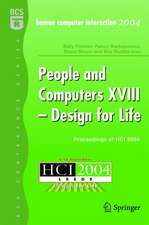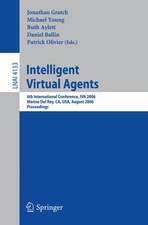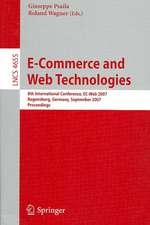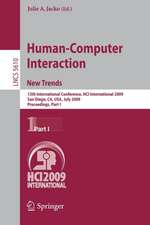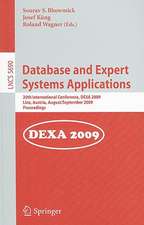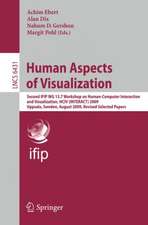Computers for Handicapped Persons: 4th International Conference, ICCHP '94, Vienna, Austria, September 14-16, 1994. Proceedings: Lecture Notes in Computer Science, cartea 860
Editat de Wolfgang L. Zagler, Geoffrey Busby, Roland Wagneren Limba Engleză Paperback – 7 sep 1994
The book contains 95 refereed contributions, including 9 scientific posters and 13 short reports, and addresses all current aspects of computers for handicapped persons and human-computer interaction from the point of view of human disabilities.
Din seria Lecture Notes in Computer Science
- 20%
 Preț: 1061.55 lei
Preț: 1061.55 lei - 20%
 Preț: 307.71 lei
Preț: 307.71 lei - 20%
 Preț: 438.69 lei
Preț: 438.69 lei - 20%
 Preț: 579.30 lei
Preț: 579.30 lei -
 Preț: 410.88 lei
Preț: 410.88 lei - 17%
 Preț: 427.22 lei
Preț: 427.22 lei - 20%
 Preț: 596.46 lei
Preț: 596.46 lei - 15%
 Preț: 448.04 lei
Preț: 448.04 lei - 20%
 Preț: 353.50 lei
Preț: 353.50 lei -
 Preț: 389.49 lei
Preț: 389.49 lei - 20%
 Preț: 309.90 lei
Preț: 309.90 lei - 20%
 Preț: 645.28 lei
Preț: 645.28 lei - 20%
 Preț: 763.23 lei
Preț: 763.23 lei - 15%
 Preț: 580.46 lei
Preț: 580.46 lei - 20%
 Preț: 310.28 lei
Preț: 310.28 lei - 20%
 Preț: 655.02 lei
Preț: 655.02 lei - 20%
 Preț: 1183.14 lei
Preț: 1183.14 lei - 20%
 Preț: 340.32 lei
Preț: 340.32 lei -
 Preț: 449.57 lei
Preț: 449.57 lei - 20%
 Preț: 591.51 lei
Preț: 591.51 lei - 18%
 Preț: 938.83 lei
Preț: 938.83 lei - 20%
 Preț: 337.00 lei
Preț: 337.00 lei - 20%
 Preț: 649.50 lei
Preț: 649.50 lei - 20%
 Preț: 607.40 lei
Preț: 607.40 lei - 20%
 Preț: 1414.79 lei
Preț: 1414.79 lei - 20%
 Preț: 1024.44 lei
Preț: 1024.44 lei - 20%
 Preț: 583.40 lei
Preț: 583.40 lei - 20%
 Preț: 453.32 lei
Preț: 453.32 lei - 20%
 Preț: 575.49 lei
Preț: 575.49 lei - 20%
 Preț: 1075.26 lei
Preț: 1075.26 lei - 20%
 Preț: 585.88 lei
Preț: 585.88 lei - 20%
 Preț: 825.93 lei
Preț: 825.93 lei - 17%
 Preț: 360.20 lei
Preț: 360.20 lei - 20%
 Preț: 763.23 lei
Preț: 763.23 lei - 20%
 Preț: 340.32 lei
Preț: 340.32 lei - 20%
 Preț: 504.58 lei
Preț: 504.58 lei - 20%
 Preț: 369.13 lei
Preț: 369.13 lei - 20%
 Preț: 580.93 lei
Preț: 580.93 lei - 20%
 Preț: 343.62 lei
Preț: 343.62 lei - 20%
 Preț: 350.21 lei
Preț: 350.21 lei - 20%
 Preț: 583.40 lei
Preț: 583.40 lei - 20%
 Preț: 583.40 lei
Preț: 583.40 lei - 15%
 Preț: 438.59 lei
Preț: 438.59 lei - 20%
 Preț: 341.95 lei
Preț: 341.95 lei - 20%
 Preț: 238.01 lei
Preț: 238.01 lei - 20%
 Preț: 538.30 lei
Preț: 538.30 lei
Preț: 353.00 lei
Preț vechi: 441.25 lei
-20% Nou
Puncte Express: 530
Preț estimativ în valută:
67.57€ • 73.42$ • 56.79£
67.57€ • 73.42$ • 56.79£
Carte tipărită la comandă
Livrare economică 21 aprilie-05 mai
Preluare comenzi: 021 569.72.76
Specificații
ISBN-13: 9783540584766
ISBN-10: 3540584765
Pagini: 652
Ilustrații: XX, 632 p.
Dimensiuni: 155 x 235 x 34 mm
Greutate: 0.98 kg
Ediția:1994
Editura: Springer Berlin, Heidelberg
Colecția Springer
Seria Lecture Notes in Computer Science
Locul publicării:Berlin, Heidelberg, Germany
ISBN-10: 3540584765
Pagini: 652
Ilustrații: XX, 632 p.
Dimensiuni: 155 x 235 x 34 mm
Greutate: 0.98 kg
Ediția:1994
Editura: Springer Berlin, Heidelberg
Colecția Springer
Seria Lecture Notes in Computer Science
Locul publicării:Berlin, Heidelberg, Germany
Public țintă
ResearchCuprins
Communications and information technology for persons with disabilities — The Canadian national strategy as an example.- An intelligent information system for blind people — AI technology and philosophical aspects.- Adapting graphical user interfaces for use by visually handicapped computer users: Current results and continuing research.- Training blind people in the use of graphical user interfaces.- Artificial visual speech synchronized with a speech synthesis system.- Notational representation of sign language: A structural description of hand configuration.- Further advances in real-time voice to text with steno interpreters.- A uniform control interface for various electronic aids.- An integrated system for communication and equipments control using radio link.- Autonomy — A flexible and easy-to-use assistive system to support the independence of handicapped and elderly persons.- Screen Reader/2 — Programmed access to the GUI.- Designing an offscreen model for a GUI.- Screen reader for Windows based on speech output.- The New Wireless LinguControl.- The FeelMouse: Making computer screens feelable.- Unexpected benefits of Voice Type computing.- Robot control methods using the RAID workstation.- The ultrasonic navigating robot, WALKY.- NavChair: An example of a shared-control system for assistive technologies.- Using spatial audio for the enhanced presentation of synthesised speech within screen-readers for blind computer users.- Multimodal concept for a new generation of screen reader.- Auditory extension of user interfaces.- An attempt to define fully-accessible workstation levels of accessibility.- Graz Brain-Computer Interface (BCI) II.- Human-computer interfacing for the severely physically disabled.- Day and assessment training technology centres.- TheNorth America association of rehabilitation programs in computer technology seeks to network with other training programs.- Disability and rehabilitation database in Chinese language.- Toward a single global market for assistive technology.- Using structure within electronic documents to make editors more accessible.- Distinguishing pattern-types in printed documents.- Structuring documents: the key to increasing access to information for the print disabled.- Study Center for Visually Impaired Persons supportive system for blind and partially sighted Students at the University of Karlsruhe/Germany.- Support Centre for Visually impaired Students.- Educational endeavour “Computer Science for the Blind” state of the art and experiences in supporting visually handicapped students.- Modellversuch “Informatik für Blinde”.- Cottage industry at NewLink.- Telework for Handicapped people: an experience.- Ableprofessionals: A recruiting and accommodation service for Atlanta employers.- ”NewsReader“ — a comfortable digital newspaper and bookreading system.- Digital talking books — a report from a practical, ongoing project.- The electronic kiosk accessing newspapers with electronic media.- Students support services at a scientific university.- Assistive technology in us higher education: The University of Wisconsin-Whitewater experience.- Leadership and Technology Management (LTM) the strategic management of technology in a consumer-driven environment.- Multimedia information system on assistive devices.- REHA — A multimedia system to learn about IT-systems for disabled persons.- Introducing voice control — Widening the perspective.- Mathtalk: The design of an interface for reading algebra using speech.- A method of access to computer aided softwareengineering (CASE) tools for blind software engineers.- Automatic image processing in developmental testing of visual-motor integration.- Computer neuropsychological training in mentally retarded children.- Computer training in cognitive remediation of the traumatic head injured.- Computer utilisation for speaking re-education.- The effectiveness of the Intonation Meter for teaching intonation to deaf persons.- Application of Artificial Intelligence methods in a word-prediction aid.- Speech therapy, new developments and results in LingWare.- Projective display of document information by parametric sound beam.- Synthesizing non-speech sound to support blind and visually impaired computer users.- Stereo sound board for real time auditory coding of visual information.- DHT — Diary handy terminal — for evaluating fluctuations in patients with Parkinson's disease (PD).- Development of the system to teach the bedsore prevention method for wheelchair users.- Development of the bedsore alarm system using microcomputer for wheelchair users.- A case study of computer analysis of the arthritic user in rehabilitation engineering.- Evaluation of Ergolab.- Dynamic displays: the changing face of augmentative communication.- BLISSVOX — Voice output communication system for teaching, rehabilitation, and communication.- Access to the text component of multimedia conversation services for non-speaking people with severe physical disabilities.- Protocolling the TINATEL-System: A contribution for long term evaluation of an AAC-system for speech impaired persons to access the public telephone network.- The conventional Braille display state of the art and future perspectives.- The concept of a full screen tactile display (FSTD) driven by electrochemical reactions.- Displayinglaterally moving tactile information.- A new architecture conception for a two dimensional tactile display.- Tactison: a multimedia learning tool for blind children.- Fortec's efforts to support mainstream education through research and technology development.- Providing assistive technology training to a rural school of education through an in-direct service strategy.- The CORES project.- Real time HCI and limits of human performance.- Computer and Computer Communication Guidance Centre for the Disabled.- Assistive technology in the public schools.- ADAMLAB Educational agency designs Voice Output Communication Aid.- Large print desktop-publishing by PC for the partially sighted.- A new approach in designing low vision aids (LVA).- Multimedia authoring systems for constructing education packages for Special Needs Education.- Computer-aided Instruction with blind persons on an audio-tactile basis.- Authoring software in special education.- Radio computer communications network for disabled people.- An investigation of Global Positioning System (GPS) technology for disabled people.- Telecommunity telecommunication for persons with mental retardation — A Swedish perspective.- Tactile-audio user interface for blind persons.- Computer-aided access to tactile graphics for the blind.- Braille reader.- Computer camp for the handicapped and their family members.- SMLLSTPS: the software version of the Macquarie Program, a computerized child assessment system.- Development and use of a speech recognition system for physically handicapped users.- Head mounted accelerometers in the control of a video cursor.- Computer assisted training programme for early intervention for children with mental retardation.








